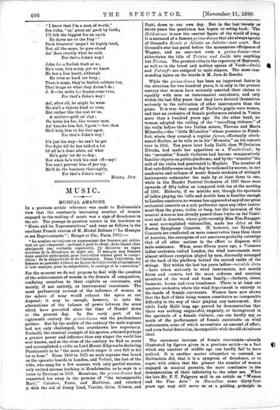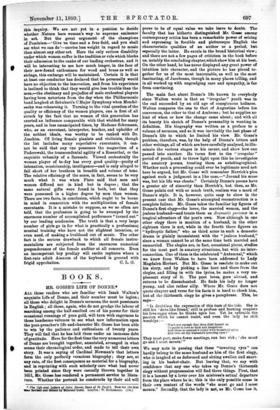MUSIC.
MUSICAL APirAZONS.
IN a previous article reference was made to Rubinstein's view that the constantly increasing number of women
engaged in the making of music was a sign of decadence in the art. The passage in question 'occurs in his brochure on "Music and its Representatives," and runs as follows in the excellent French version of M. Michel Delines ("La Musique et see Representants"; Heugel et Cie., Paris, 1892):— " Le nombre va loujours en aup.:mentant des femmes qui execn- tent ou qui compoeent : mettant a part is chant, dens lequel elles atteignent une v6ritab1e superiorite, j'y decouvre un signe nouveau de la decadence de notre art. 11 manque aux femmes deux qualites principales, pour l'ex6cution comme pour la compo- sition: de la subjectivite et de l'initiative. Dans l'execution, les femmes no peuvent s'elever an dens de l'objectivite (lluaitation); ii leur manque, pour la subjectivite, le courage et la conviction."
For the moment we do not propose to deal with the question of the achievements of women in the domain a composition, confining ourselves to their exploits as executants, and mainly, if not entirely, as instrumental executants. The most perfunctory account of the influence of women in the sphere of song would exhaust the space at our disposal; it may be enough, however, to note the alternations of the balance of • power between the sexes which have prevailed since the time of Handel down to the present day. In the early • part of the eighteenth century the prinia-donna was the predominant partner. Bat by the middle of the century the male soprano had not only challenged, but overthrown her supremacy.
Farinelli, the classical example of his species, attained perhaps a greater power and influence than any singer the world has ever known, and at the close of the century we find so acute and accomplished a critic as Lord Mount-Edgcumbe declaring
Paco. hierotti to be "the most perfect singer it ever fell to his lot to hear." From 1800 to 1825 no male soprano was heard on the operatic boards in London, and Velluti, the last of the tribe, who sang for a few seasons with only partial success, only excited intense loathing in Mendelssohn, as be says in a letter to Devrient in 1829. Meantime, the prima-donna had reasserted her sway in the persons of "the incomparable Bard," Ce.talaid, Pasta, and Malibran, and retained it With the aid of Jenny Lind, Viardot, Griai, Nilsson, and Patti, down to our own day.- But in -the last-twenty or thirty years the pendulum has begun to-swing back. The Ifeldentenor is now the central figure of the world of song. It is narrated of a famous prima-donna that site always speaks of Gounod's Romeo et Juliette as Juliette—tout court. But Gounod's star has paled before the momentous effulgence of Wagner, and no one—not even a prima-dorina---ever abbreviates the title of Tristan und Isolde into anything but Tristan. The greatest roles in the repertory of Bayreuth, as well as in the latest and noblest operas of Verdi—Otello and l'alJtaff—are assigned to male singers. The most com- manding figure on the boards is M. Jean de Reszke.
While the prima-donna has been an important factor in the situation for two hundred years, it is only in the present century that women have seriously asserted their claims to equality with men as instrumental executants, and only within the last fifty years that they have devoted themselves seriously to the cultivation of other instruments than the piano. It is true that many of Tartini's pupils were women, and that an orchestra of female performers existed in Venice more than a hundred years ago. On the other hand, no woman adopted the calling of the "travelling virtuoso" of the violin before the two Italian sisters, Theresa and Maria Milanollo,—the "little Milanollos" whose presence in Frank- fort, where they created a regular furore, effectually check- mated Berlioz, as he tells us in his "Memoirs," on his concert tour in 1841. Ten years later Lady Halle, then Wilhelmina Neruda, had made her apparition as a Wunderkind ; by the " seventies " female violinists had become comparatively familiar objects on public platforms; and by the "nineties" the cult of the violin had penetrated to Mayfair. The number of first-rate fiddleresses may to-day be reckoned by scores ; in our academies and colleges of music female students of tringed instruments outnumber the male by at least three to one, while in the Handel Festival Orchestra of 1897 there were upwards of fifty ladies as compared with ten at the meeting of 1891. Hitherto, if we mistake not, though the spectacle of ladies playing the 'cello and double bass is familiar enough to London amateurs, no woman has appeared at any of our great orchestral concerts as a solo performer upon any other instru- ment than the piano, violin, or harp, but the incursion, of the musical Amazon has already passed these limits on the Conti-. nent and in America, where quite recently Miss Elsa Rnegger, a most accomplished violoncellist, made her debut at the Boston Symphony Concerts. If, however, our Symphony Concerts are conducted on more conservative lines than those of America, the enterprise of our amateurs probably outstrips that of all other nations in the effort to dispense with male assistance. When, some fifteen years ago, a Viennese ladies' orchestra visited London, the wind instruments were almost without exception played by men, discreetly arranged at the back of the platform behind the serried ranks of the strings. But within the last ten years ladies—part/bile dictu —have taken seriously to wind instruments, not merely, flutes and cornets, but the more arduous and exacting members of the wood and brass family,—clarinets, oboes, bassoons, horns, and even trombones. There is at least one amateur orchestra where the wind department is entirely in the hands of female executants. Women have now shown that the fact of their being women constitutes no insuperable difficulty in the way of their, playing any instrument. But while Lady Halle long ago proved by demonstration that there was nothing ungraceful, ungainly, or incongruous in the spectacle of a female violinist, one can hardly say as much of the performance of female executants on wind instruments, some of which necessitate an amount of effort, and even facial distortion, incompatible with the old chivalrous ideal.
The enormous increase of female executants—already illustrated by figures given in a previous article—is a fact which any amateur of middle age can hardly fail 'to have noticed. It is another matter altogether to contend, as Rubinstein did, that it is a symptom of decadence, or to argue with others that the greater the number of women engaged in musical pursuits, the more conclusive -is the demonstration of their inferiority to the other sex. What the late Mr. F. T. Palgrave said in an article on "Women and the Fine Arts" in Macmillan some thirty-four years ago may still serve us as a guiding _principle in. this inquiry. We are not yet in a position to decide whether Nature bars woman's way to supreme eminence in art. But the great argument of the champions of Feminism—' Give us time and a free field, and you shall see what we can do '—carries less weight in regard to music than almost any other art. Here the only serious disability under which women suffer is the tradition or rule which blocks their admission to the ranks of our leading orchestras, and it will be interesting to see how much longer, in the face of their new-found enthusiasm for wood and brass as well as strings, this embargo will be maintained. Certain it is that at least one conductor has declared that he personally would have no objection to the innovation, and from his experience is inclined to think that they would give lees trouble than the men,—the obstinacy and prejudice of male orchestral players having been notorious from the day when the Philharmonic band laughed at Schubert's C Major Symphony when Mendel- ssohn was rehearsing it. Turning to the vital question of the quality or efficiency of the women players, one is first of all struck by the fact that no woman of this generation has exerted an influence comparable with that wielded for many years, and in less emancipated times, by Madame Schumann, who, as an executant, interpreter, teacher, and upholder of the noblest ideals, was worthy to be ranked with Dr. Joachim. Of living female pianists and violinists, though the list includes many superlative executants, it can- not be said that any one possesses the magnetism of a Paderewski, the transcendental agility of a Rosenthal, or the exquisite urbanity of a Sarasate. Viewed orchestrally the woman player of to-day has every good quality—purity of intonation, musicianship, intelligence—and is only alleged to fall short of her brethren in breadth and volume of tone. The relative efficiency of the sexes, in fact, seems to be very much what it was when Plato said that men and women differed not in kind but in degree ; that the same natural gifts were found in both, but that they were possessed in a higher degree by men than women. There are two facts, in conclusion, which ought to be borne in mind in connection with the multiplication of female executants. It is a mistake to suppose, as we so often are told, that the profession is going to be swamped by the enormous number of accomplished performers 'turned out" by our leading academies. The truth is that a very large number of girls go in for what is practically a professional musical training who have not the slightest intention, or even need, of making a livelihood out of music. The other fact is the serious drawback to which all female instru- mentalists are subjected from the enormous numerical preponderance of the female auditor at all concerts. Even an incompetent boy prodigy will excite raptures where a first-rate adult Amazon of the keyboard is greeted with











































 Previous page
Previous page